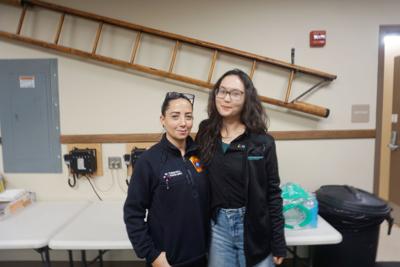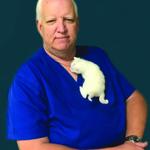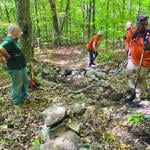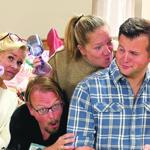LACONIA — Winnie Tunstall, the city's new community paramedic, has been in the job for about a year. In that time, her work is already making a significant impact in filling gaps in the outpatient medical setting.
The community paramedic position is part of the Mobile Integrated Health program, which has served nearly 200 patients so far.
The MIH program, funded by grants for three years, consists of two distinct parts, in essence: the community paramedic program, run through the Laconia Fire Department, and a community health worker, supervised by the Partnership for Public Health.
Last year, PPH secured the grants to start the pilot program, funded by the federal Health Resources and Services Administration and the Rural Northern Border Region Outreach Program. It came in at $250,000 per year for three years, set to renew each September. The goal of the pilot program was, at the time, to develop data on its efficacy, and to discern whether emergency services would be able to bill insurance companies.
MIH is an effort by licensed services providers to meet patients where they are, affording them access to health care and other social or medical resources outside of a hospital. It’s relatively new in New Hampshire, though the Monadnock area has run a similar program for several years, and there’s evidence from other locations around the United States that such programs are effective.
Tunstall, along with Emma Petersen, public health program administrator for PPH tasked with overseeing the grant, say they’ve been able to fill gaps in the health care system over the inaugural year of the program.
“This is not emergency services,” Petersen said Thursday evening. “This is entirely different.”
“It’s all about meeting people where they are.”
Tunstall and Faith Pakasuk, the community health worker, play related but different roles. Tunstall’s role is clinical, while Pakasuk is tasked with confronting social determinants of health, which are non-medical conditions impacting someone's health and prosperity.
“We are both collecting data actively,” Tunstall said Thursday night. They’ll collect data regarding the rates of patient contact and patient use of hospital emergency departments and emergency medical services, among other items.
Over the first year of the program, since September 2024, Pakasuk has served about 115 individuals, and since Feb. 17, Tunstall has served another 70 across 265 patient contacts. One measure of success is the number of patient contacts each year — 100 by the end of the first year, and 300 by the end of the third — a measure they’ve quickly surpassed. Tunstall said Thursday they reasonably expect to hit the 300-mark at some point in December.
Tunstall is able to provide emergency care if needed, as well as educate, work to reduce rates of hospital readmission, connect patients to social services and primary care, and help coordinate disease management. Pakasuk is the go-to person with regard to managing the link between a patient and social services. A community health worker is an expert at facilitating access to services, helping patients through byzantine bureaucracies and, ultimately, improving delivery of services.
The community need for this work is great — the goal is to reduce unnecessary trips to the hospital and, ultimately, prevent death. For Tunstall’s part, her job starts when an emergency services teams’ ends. When fire department paramedics respond to a call and assess a patient would be a candidate for mobile health, Tunstall sets follow-up appointments and works to identify their needs.
“It’s about reducing the number of preventable trips to the ER,” Petersen said, saving those resources to be focused on “true emergencies.”
One of Tunstall’s patients, who called for an ambulance ride upward of 60 times last year, has reduced that number to about 10 since working with mobile health workers. That’s better for the patient, who won’t rack up incredible medical transportation bills, and will more likely receive the care they need. It's also better for the city, saving first responders for serious medical emergencies. Services provided by Tunstall and Pakasuk are free for patients.
For the patient with frequent ambulance trips, Petersen and Tunstall agreed the most important intervention was advocacy, helping them manage their symptoms and reducing or preventing their perceived need to call for an ambulance.
Though there are many services available to all patients, navigating those services is often difficult for people with the most need.
“These things are really hard to do for someone who needs the services,” Petersen said.
“It’s not just great for the patients, it’s great for the provider,” Tunstall said. Partners including Concord Hospital-Laconia express frequent enthusiasm for the interdisciplinary approach. For example, about 62% of Pakasuk's referrals to PPH came through the city’s hospital. Of the remainder, 50% came to PPH from Tunstall.
“We’re not trying to step on anyone’s toes, we’re trying to fill the gaps,” Petersen said.
Focusing on patient-specific reasons for calling an ambulance — and not all are strictly medical, in the traditional sense — reduces the number of lower-severity calls, saving first responders' attention for patients with acute or emergency needs. Preventive and follow-up care in turn reduces future, unnecessary ambulance rides.
Reducing barriers to primary care and preventive medical treatment is a big deal in Laconia — in the period between 2021 and 2023, 51% of medical incidents in the city occurred at properties operated by Laconia Housing, 16% at the Taylor Community and 14% at Genesis Laconia Rehabilitation Center, along with visits to St. Francis and other nursing homes. The largest discrete users of emergency transport in that period combined for fully one-quarter, 1,169, of total incidents.
According to the Centers for Disease Control and Prevention, an estimated 40% of emergency department visits involve patients who could be effectively treated in non-urgent settings.
“Many patients with chronic conditions visit the ED because of preventable exacerbation of their condition caused by poor access to primary care, a lack of knowledge about managing their condition, or poor self-management of their condition,” according to the CDC. “Unnecessary ED visits could be prevented by adopting preventive and coordinated ambulatory care that addresses social determinants of health.”
Though the program appears broadly successful so far, Petersen and Tunstall agreed there are hurdles. Transportation to and from appointments for patients, for example, is difficult in this area. Tunstall noted that challenge is likely among the top problems individuals face in Laconia.
Because the community health concept, at least in terms of implementation, is rather new to New Hampshire, there are kinks to be worked out. For example, Petersen and Tunstall described the “ever-complicated” system of documentation required between steps. Electronic medical record systems at health care facilities and the first responders system don’t easily integrate, and “the wheels of bureaucracy turn slow.”
Public faith in the health care system is also shaky at times, Petersen said, due in part to factors including understaffed medical services, and the immense difficulty some patients experience navigating health and social services.
“There’s a loss of faith in the system,” Petersen said. “Sometimes, it’s just not there.”
The so-called “seed money” for the program is set to expire in September 2027, but administrators say they’re hopeful they’ll be able to secure additional funding to continue and, potentially, expand the program. Collecting data to strengthen the case and demonstrate need is an important step in securing funding down the road.
“We’re hopeful, there is sustainability,” Petersen said. “The community support has been fantastic.”
So far, mobile health programs appear to be effective in achieving their goals. The concept is growing in the Granite State, as small teams statewide — like the one right here in Laconia — are working to figure it all out.
“I’m sure we’ll get there,” Petersen said.


















(0) comments
Welcome to the discussion.
Log In
Keep it Clean. Please avoid obscene, vulgar, lewd, racist or sexually-oriented language.
PLEASE TURN OFF YOUR CAPS LOCK.
Don't Threaten. Threats of harming another person will not be tolerated.
Be Truthful. Don't knowingly lie about anyone or anything.
Be Nice. No racism, sexism or any sort of -ism that is degrading to another person.
Be Proactive. Use the 'Report' link on each comment to let us know of abusive posts.
Share with Us. We'd love to hear eyewitness accounts, the history behind an article.